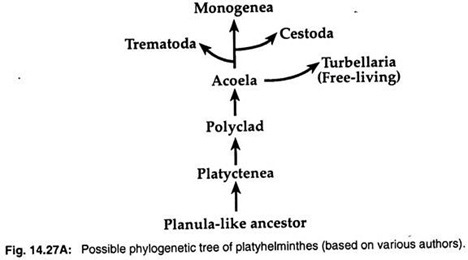Causes:
The disease filariasis is caused by filarial worms Filaria bancrofti or Wuchereria bancrofti and Wuchereria malayi.
They belong to the Phylum – Nemathel- minthes and class- Nematoda.
The adult worms are slender and thread like in appearance and live in the lymph gland and lympth vessels of man.
The female is larger than the male (Fig. 6(A).12 & 6(A).13).
The female measures 100 mm in length and 0.25 mm in diameter whereas the males are only 40 mm in length and 0.1mm in diameter. The tail of male is coiled and with two unequal spicules. These two spicules help in the process of copulation.
Their body colour is creamy white. The anterior end of the parasite is swollen slightly and without lips. Certain species of culex mosquito (Culex fatigans, C. quinquefasciatus) bring about transmission of the parasites from infected person to healthy persons.
Life Cycle:
Like malarial parasite the life cycle of Filaria bancrofti is digenetic involving two hosts: man and female culex mosquito (Fig. 6(A).6). Following mating the female worm lays eggs which hatches to give rise to larvae or juveniles called microfilariae. Each microfilaria is enclosed in a dedicate sheath and measures about 0.22 mm in length. The microfilariae show nocturnal periodicity i.e., they appear in peripheral circulation of man between 10 P.M. and 4 A.M. (to be sucked by mosquito) but live in deeper blood vessels during the day time.
Further development of microfilariae occurs if they are sucked by the mosquito species of Culex, Anopheles and Aedes which act as vectors. In the mosquito gut the microfilariae lose their sheath and migrate to thoracic muscles and undergo two moultings (cast off old skin) there. It is the infective stage which requires two weeks time for development.
Then they migrate to the labium of mosquito when the infected mosquito bites a healthy person the microfilariae get under the skin and later migrate into the lymphatic system of man. There they undergo third and fourth moult and develop into adult. In the host body the adults live up to about 4 to 5 years.
Symptoms of Filaria:
The adult worms obstruct the lymph vessels and cause some inflammation. This causes increased amount of protein to enter the area and excessive growth of connective tissue. These cause enlargement of arms, legs, scrotum, epididymis etc. Extreme enlargement of legs is known as elephantiasis (as they resemble the leg of elephant) (Fig. 6(A).16). The patient suffers from periodic fever associated with headache and mental depression.
Treatment:
To destroy the microfilariae an antimony compound Neostibosan is used as an effective drug, Arsenamide is also used. The arsenamides are given intravenously. Diethyl carbamozine is used against adults and microfilariae.
Prevention and Control Measures:
1. To control the mosquito population mosquito breeding grounds should be destroyed. This is achieved by spraying D.D.T., Gammaxene etc., clearing the unwanted bushes from the surroundings, spreading oil or kerosene in drain, swamps etc.
2. At the time of sleeping mosquito net should be used.
3. Mosquitoes can be prevented from biting by use of mosquito repellants, lotions etc.
4. By taking heterazan drug filariasis can be prevented.
5. The National Filaria Eradication Programme (NFEP) launched by the Government of India has been effective in reducing the occurrence of filariasis in our country.




